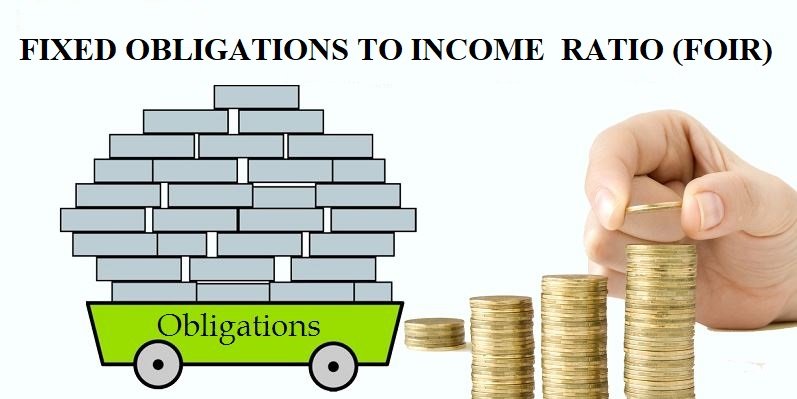
If you’ve ever lent a friend money, you know it carries a certain risk of whether or not you’re ever going to get it back. Banks lend to borrowers on a similar but much larger scale and the risk they keep is much higher because lending is a big part of their business.
The money that banks lend is generally financed from the deposits they obtain from their clients and they are responsible for safeguarding this money as a legally registered entity and giving it back to clients with guaranteed returns.
The bank’s non-performing assets would increase and damage their company as bad debts grow. The need to follow a sophisticated formula with such high stakes to quantify the risk of lending to a specific borrower, whether it is an entity or a corporation, and primarily decide whether they will be able to repay the loan.
FOIR Meaning
The full form of FOIR is the fixed income commitment ratio and the measurement of an individual’s fixed monthly outgo as a percentage of his/her net income per month. It is a true representation of one’s discretionary income and reveals one’s potential for repayment.
The FOIR estimate also involves EMIs payable to the lender for a future loan that the borrower has sought. It is also known as the ratio of debt-to-income.
Based on which loan applicants are assessed, FOIR is one such restrictive specification. For personal loan approvals, evaluation of an applicant’s FOIR is usually relevant as these are unsecured advances and carry a higher degree of risk for the lenders. An description of the value of FOIR, its measurement and how it affects the approval of personal loans is given below.
Between 40 percent and 50 percent is the perfect FOIR in banking terms that lenders favour when reviewing personal loan applications. This implies that all the fixed monthly obligations owed by a person do not exceed 50 percent of the month’s net income. The FOIR will go up to 65 to 70 percent based on lender policies for people with high net worth..
Take a look at its estimation and effect on personal loan approval with this understanding of FOIR.
Statutory income exemptions such as the Provident Fund, skilled tax and deductions for savings such as insurance or a revolving deposit are not included in the fixed obligations.
In the measurement of the FOIR, the banks and financial institutions take note of the applicant’s profits and of the instalments of all the loans already being paid by the applicant. It also considers the prospective loan’s Equated Monthly Instalment (EMI) that is under consideration.
FOIR varies from bank to bank and case to case, but it should be between 40 percent and 55 percent on average.
FOIR Calculation
List all fixed monthly commitments to measure FOIR, which could include EMIs for current loan repayments, Credit card bills And debt obligations, if any Rent payments Other recurring living expenses.
Fixed Obligation to Income Ratio(FOIR) = Sum of all fixed monthly obligations(including installments for loan, credit card and other rental obligations) /Net salary per month x 100
Let’s take an example:

Mahesh has a monthly income of ₹ 30,000; an AC loan instalment of ₹ 3,000; another instalment of ₹ 7, 000 for a vehicle loan; and a home loan instalment for ₹ 9,000.
That is, he pays a total of ₹ 19,000 per month for all his financial obligations.
Now, when he applies for credit, his approval gets rejected!
In the example above, Mahesh spends his money every month paying following instalments:
- AC instalment of ₹ 3,000
- Vehicle loan instalment of ₹ 7,000
- home loan instalment of ₹ 9,000
Sum of all Fixed Obligations = ₹ 19,000
Mahesh’s Monthly Income = ₹ 30,000
= 19,000/30,000 x 100
= 63.33%
Mahesh’s FOIR is more than 50%, hence his application for a credit was rejected.
Through Mahesh’s FOIR bank got that Mahesh would have difficulty paying back all EMIs since the FOIR is already over 50% of his current income.
Mahesh can only get more credit once he repays any one of his previous loans and gets a salary boost.
Effects of FOIR

Owing to the absence of collateral, personal loans subject lenders to a greater degree of risk. The FOIR of an applicant represents a vital reflection of its capacity to make timely EMI payments. Therefore, lenders specify FOIR as a key test of eligibility for applicants for personal loans.
You should hold all fixed obligations limited to less than 50 percent of net monthly income, including EMIs on the new loan submitted, or the FOIR on a personal loan as stated by your lender.
The bank sends an inquiry to the credit bureau when you apply for some loan or credit from a bank. These inquiries are reported and reflected in your credit report, impacting your credit score as a result. They can work against you by lowering your credit score if there are too many such inquiries. Hence before you apply for a loan, it is recommended that you measure your FOIR.
What to do if FOIR is High

People with a higher FOIR can use the following strategies to increase their chances of approval. Pay off an unpaid credit liability. Apply with a co-signer who holds a low FOIR. Comply with any other eligibility requirements provided by the chosen lender.
Report to the lender every other daily source of income. A combination of low FOIR and high credit score enables an individual to access ample availability.
If you are uncertain about your new loan because your Income Ratio of Fixed Commitments is higher than the margin of the bank concerned, you can apply for a loan with another working applicant. The burden of the EMI payment would be split in that case.
For example, the additional payments can easily be split by a married working couple; therefore, if they want to jointly use a loan, they would have greater chances of loan approval.






